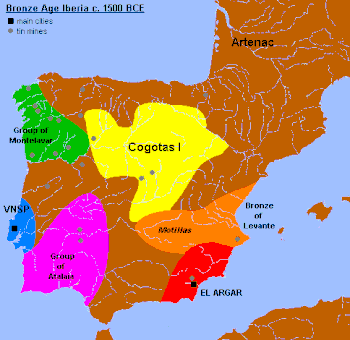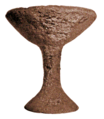El Argar

El Argar is an Early Bronze Age culture that was based in Antas, Almería, within modern Spain. It is believed to have been active from about 2200 B.C. to 1500 B.C.[1][2][3] The people developed sophisticated pottery and ceramic techniques that they traded with other Mediterranean tribes.[4]
The civilization of El Argar extended to all the province of Almería, north onto the central Meseta, to most of the region of Murcia and westward into the provinces of Granada and Jaen, controlling an area similar in size to modern Belgium.[5]
Its cultural and possibly political influence was much wider. Its influence has been found in eastern and southwestern Iberia (Algarve), and it likely affected other regions as well.
Some authors have suggested that El Argar was a unified state.[5]
Material culture[]
El Argar is the cultural center of the Early and Middle Bronze Age in Iberia. Metallurgy of bronze and pseudo-bronze (alloyed with arsenic instead of tin) was practiced. Weapons are the main metallurgic product: knives, halberds, swords, spear and arrow points, and big axes with curved edges are all abundant, not just in the Argaric area, but also elsewhere in Iberia.
Silver was also exploited. Gold had been abundantly used in the Chalcolithic period, but it became less common in El Argar culture. Discovery in 2014 of an especially rich grave and an associated building at La Almoloya have provided important details about the culture. The archaeological site is in a southeastern portion of the Iberian Peninsula. The richness of the burials of its women has led to some re-evaluation of the place of women in this Early Bronze Age culture.
The women at this site were buried with numerous grave goods of silver, treasure that suggests that women held high status in the society. For instance, excavation of Grave 38 began in 2014,[6] and it contains burial goods estimated to be worth tens of thousands of dollars and included a diadem. The burial was found below a unique building, when compared to the others excavated. The building above the grave appears to be a great hall, with benches along the sides that could seat up to 50 people. This suggests that the hall was used for politics. The grave and hall have been radiocarbon dated to approximately 1700 BC.[1]
Periodization[]
The culture of El Argar has traditionally been divided in two phases, named A and B.
El Argar A[]
Phase A started in the eighteenth century BC, with the earliest calibrated C-14 dates pointing to the first half of that century:
- 1785 BC (+/- 55 years) in the transitional Late Chalcolithic-Early Bronze of , a peripheral site
- 1730 BC (+/- 70 years) in Fuente Álamo for El Argar A2, with six undated A1 layers under it
- 1700 BC in (another peripheral site) with identifiably Argarian materials in its lower layer
El Argar B[]
Phase B begins in the sixteenth century BC. The main C-14 date is that of 1550 BC (+/- 70 years) in Fuente Álamo for the upper layer of El Argar B2 (with four layers underneath the lowest B phase). Other stratigraphic dates are somewhat more recent, but are not confirmed by C-14.
Post-Argarian phase[]
El Argar B ends in the fourteenth or thirteenth century BC, giving way to a less homogeneous post-Argarian culture. Again, Fuente Álamo gives the best C-14 dating with 1330 BC (+/- 70 years).
Recent trends[]
Many more C-14 dates have been published since the beginning of the twenty-first century. In recent publications, at least 260 such dates are cited altogether. There is now a widespread consensus that the emergence of El Argar can be dated at 2200 cal BC, although its end remains somewhat disputed. Various opinions place the end of El Argar at fifteenth-fourteenth centuries BC.[7]
Gallery[]

Grave goods

Ceramic cup
El Argar
Typical jar burial
El Argar B
Woman's skull
with diadem
References[]
- ^ a b Lull et al., "Emblems and spaces of power during the Argaric Bronze Age at La Almoloya, Murcia,", Antiquity, Cambridge University Press, 11 March 2021
- ^ Lull, Vicente; Micó, R.; Rihuete Herrada, Cristina; Risch, Roberto (2011). "El Argar and the Beginning of Class Society in the Western Mediterranean". Archäologie in Eurasien. 24: 381–414.
- ^ Pinkowski, Jennifer (March 11, 2021). "She Was Buried With a Silver Crown. Was She the One Who Held Power?". New York Times.
- ^ Lull, Vincente; Micó, R.; Rihuete Herrada, Cristina; Risch, Roberto (2013). "Bronze Age Iberia". The Oxford Handbook of the European Bronze Age. Oxford University Press: 594–616. ISBN 9780199572861.
- ^ a b Eiddon, Iorwerth; Edwards, Stephen (1973). The Cambridge Ancient History. p. 764.
- ^ Pinkowski, Jennifer, You Should See Her in a Crown. Now You Can See Her Face, Science Times, New York Times, November 23 2021
- ^ Gonzalo Aranda Jimenez, Sandra Montón Subías, Margarita Sánchez Romero, The Archaeology of Bronze Age Iberia: Argaric Societies. Volume 17 of Routledge Studies in Archaeology, 2014 ISBN 1317588916 p34
Bibliography[]
- Castro, Pedro V. (2001). "La sociedad argárica". In Ruiz-Gálvez Priego, Marisa (ed.). La Edad del Bronce ¿Primera Edad de Oro de España? Sociedad, economía e ideología. Barcelona: Crítica. ISBN 84-8432-299-8.
- Eiroa García, Jorge Juan (2010). Prehistoria del mundo (1st ed.). Barcelona: Sello Editorial SL. ISBN 978-84-937381-5-0.
- Gilman Guillén, Antonio (1999). "Veinte años de Prehistoria funcionalista en el sureste de España". Boletín del seminario de estudios de Arte y Arqueología (BSAA) (65): 73–98. Retrieved 8 April 2018.
- González Marcén, Paloma; Lull, Vicente; Risch, Robert (1992). Arqueología de Europa, 2250-1200 a. C. Una introducción a la "Edad del Bronce" (1 ª ed.). Madrid: Síntesis. ISBN 84-7738-128-3.
- Izquierdo Egea, Pascual (2016). "Midiendo las fluctuaciones de la economía argárica a través del registro funerario" (PDF). Arqueología Iberoamericana. 30: 77–90. ISSN 1989-4104.
- Lull, Vicente (1983). "La cultura del Argar. Un modelo para el estudio de las formaciones económico-sociales prehistóricas" (PDF). Madrid. Archived from the original (PDF) on 1 October 2018. Retrieved 8 April 2018. Cite journal requires
|journal=(help) - Siret, H.; Siret, L. (2006) [1890]. Las primeras edades del metal en el sudeste de España (Álbum) (pdf). Edición facsimilar. Murcia: Museo Arqueológico de Murcia. Retrieved 8 April 2018.
External links[]
- Official website
 Media related to El Argar at Wikimedia Commons
Media related to El Argar at Wikimedia Commons
- Prehistoric sites in Spain
- Archaeological sites in Andalusia
- Bronze Age Spain
- Algarve
- Ancient pottery
- Almería
- Murcian culture



